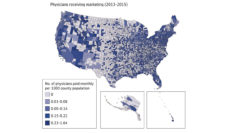African Americans disproportionately inherit sickle cell disease (SCD). The condition occurs in approximately one out of every 365 Black births. SCD is a group of disorders that impact hemoglobin, the molecule in red blood cells responsible for transporting oxygen throughout the body. For people living with sickle cell disease, their red blood cells become hard and sticky and take the shape of a crescent moon. These “sickled” cells get stuck in blood vessels, clogging blood flow, and die, causing red blood cell destruction and intense pain.
Sickle cell disease is associated with a range of symptoms and complications including anemia, infections like pneumonia and meningitis, and acute and chronic pain. Many individuals afflicted with SCD depend on prescription opioids to cope with pain.
Cynthia B. Sinha and colleagues recently conducted a qualitative study to explore the effects of the opioid epidemic on African Americans living with sickle cell disease. The researchers conducted interviews with 15 adults diagnosed with SCD who reported experiencing pain three or more days a week and had a current opioid prescription. Three major themes emerged from these conversations.
First, participants explained that their opioid prescriptions had become more closely monitored, more limited, and challenging to fill. Barriers to optimal care included restrictions to the number of prescriptions allowed by health insurance companies or inadequate pharmacy supplies of opioids. Participants reported that these barriers led to patients rationing their medication and being unable to receive additional medication doses when there is an unexpected and urgent need for pain relief. Some participants in the study had been asked to sign treatment agreements with their physicians pledging not sell their opioids or go “doctor shopping.”
Those with SCD are caught between the rock of a chronic disease and the hard place of a health care provider community trying to cut back on opioid prescriptions.
Second, participants described that their physician’s focus on monitoring medication led to discriminatory care and prescribing. Participants, many of whom had worked with a single physician for years, felt they were frequently stigmatized as drug seekers. Participants revealed that their physicians had lost an earlier focus on more holistic care. One participant said, “They just ask me what my pain is. They ask me how my pain is. You okay with just using morphine? Yes. Okay and that’s about it and they take my blood work. That’s all the conversation I have. I’ve never had any real in-depth conversation concerning pain management.”
The final theme that emerged was a growing interest in alternative therapies to cope with pain. Participants reported using hot baths and warm compresses, meditation, reading, praying, music, and art to soothe pain. Participants indicated newer interest in other approaches like acupuncture, physical therapy, and marijuana.
African Americans accounted for 12% of opioid fatal overdoses in 2017. However, much of the current response to the opioid epidemic has centered lower- and middle-class white Americans and overlooked the impact in Black communities. From the perspective of study participants, all of whom had severe intermittent pain, the opioid epidemic has led to decrease in access to opioids and increased stigmatization. Those with SCD are caught between the rock of a chronic disease and the hard place of a health care provider community trying to cut back on opioid prescriptions.
Photo by Haley Lawrence on Unsplash














